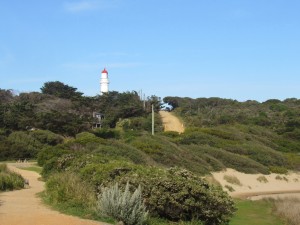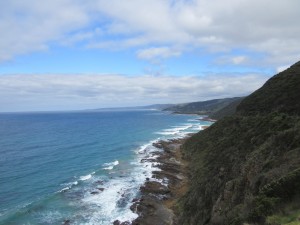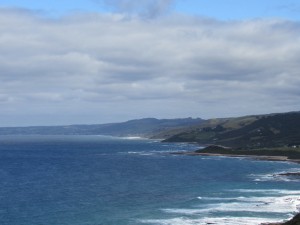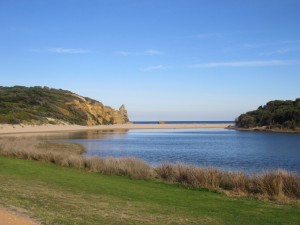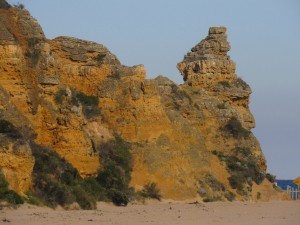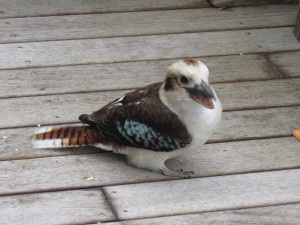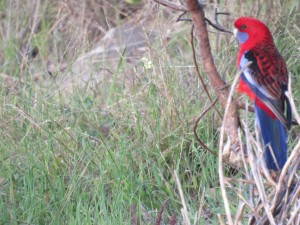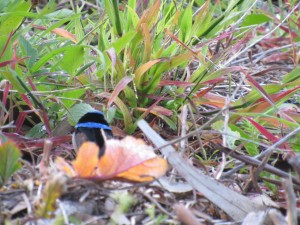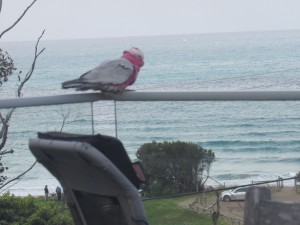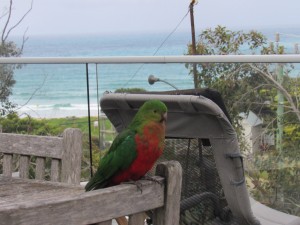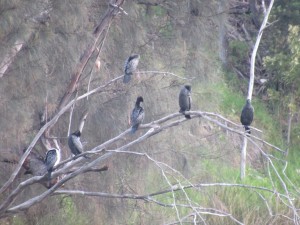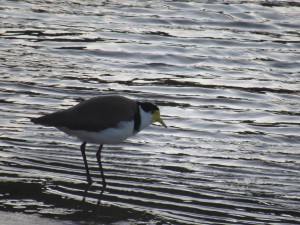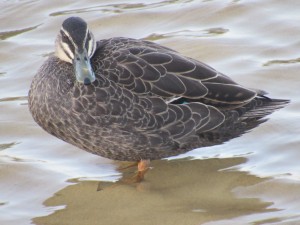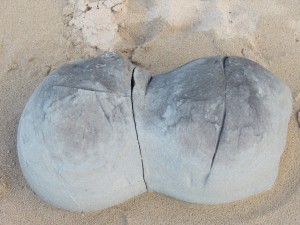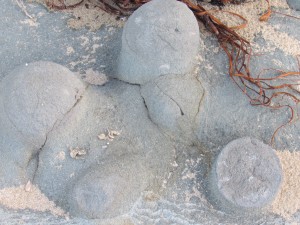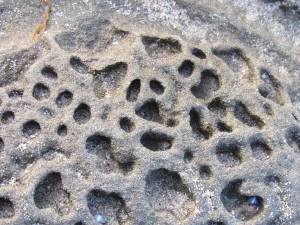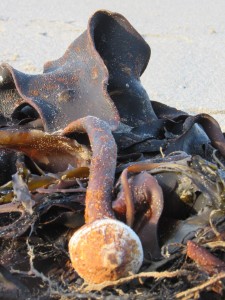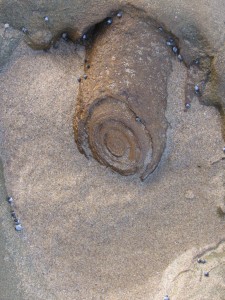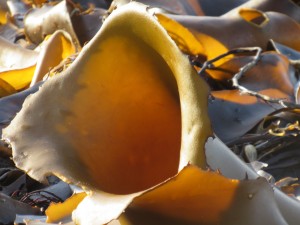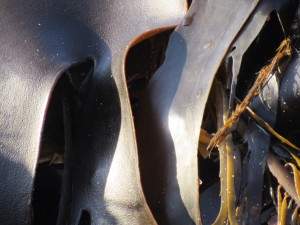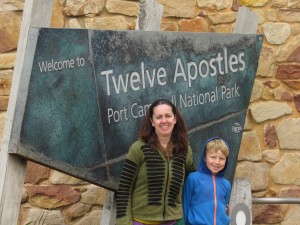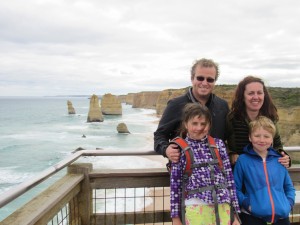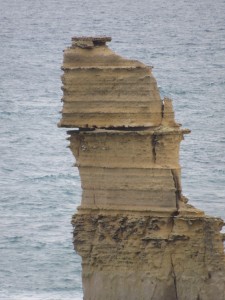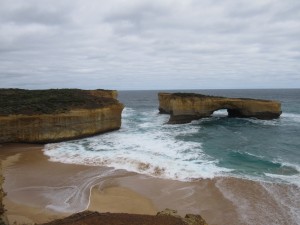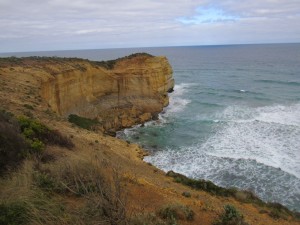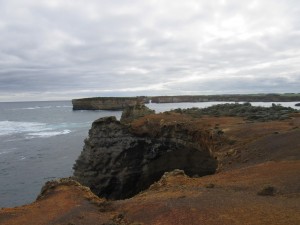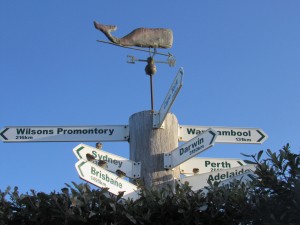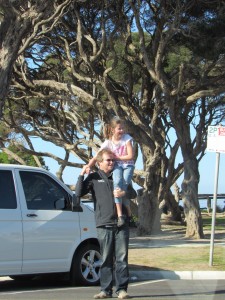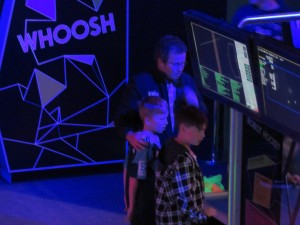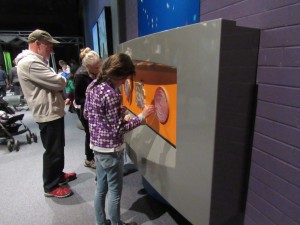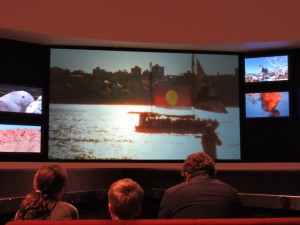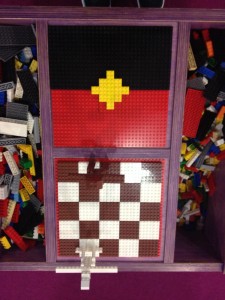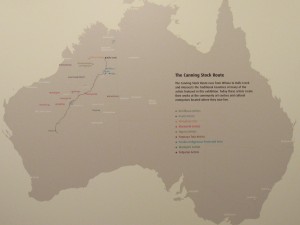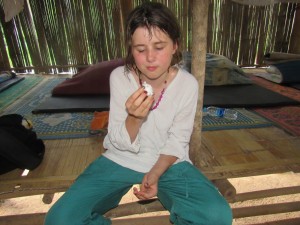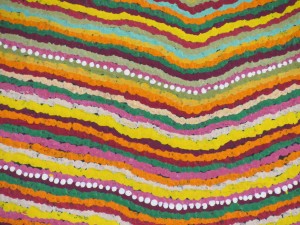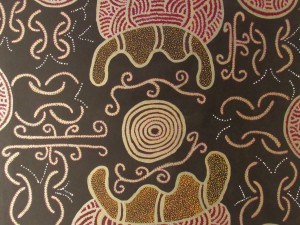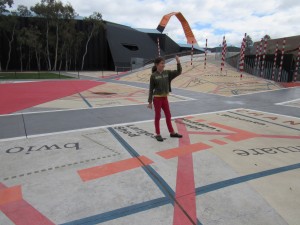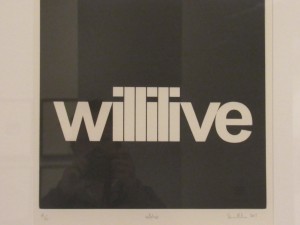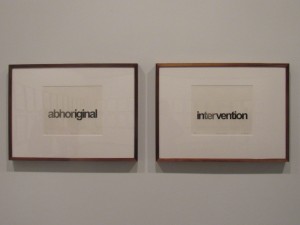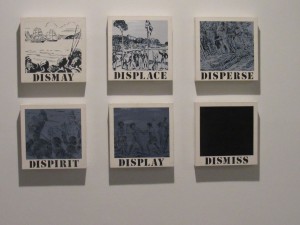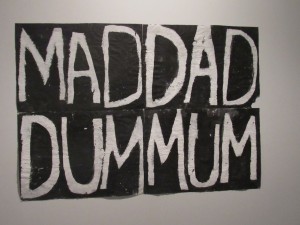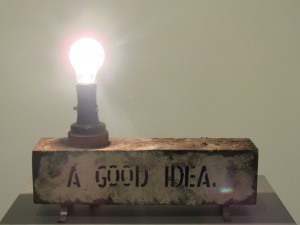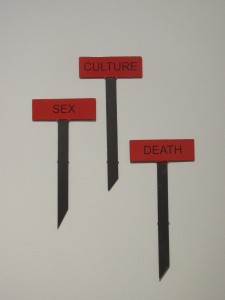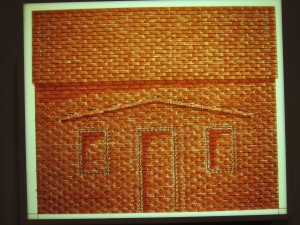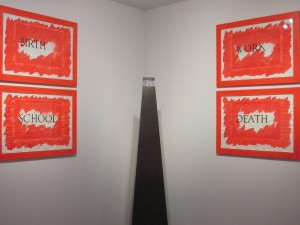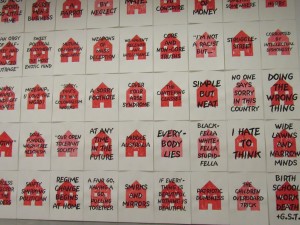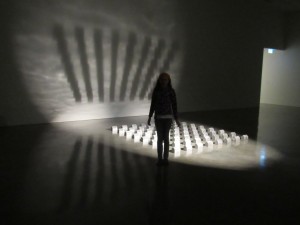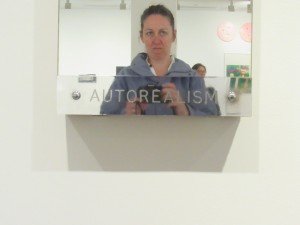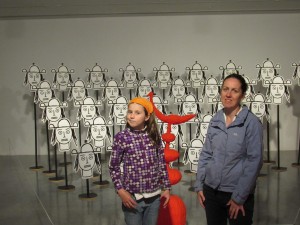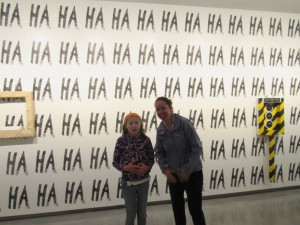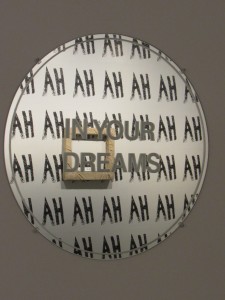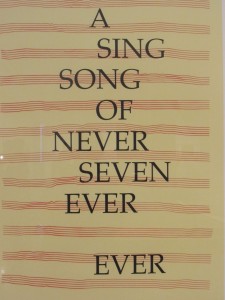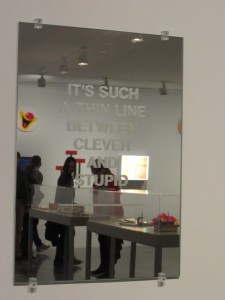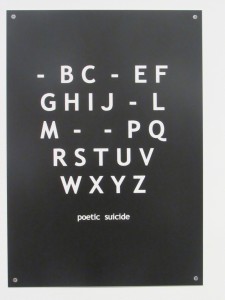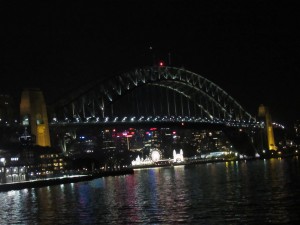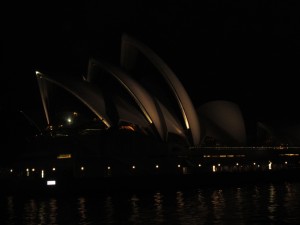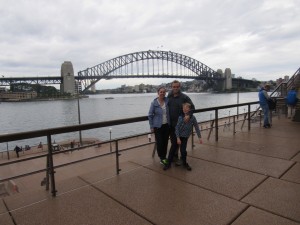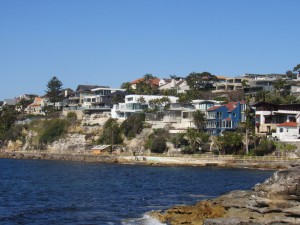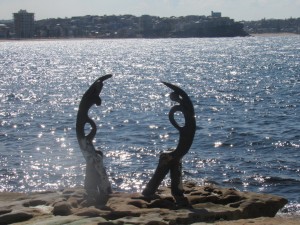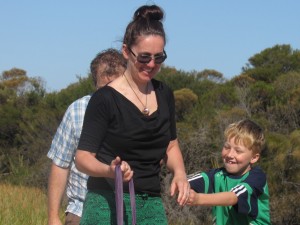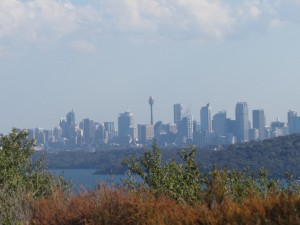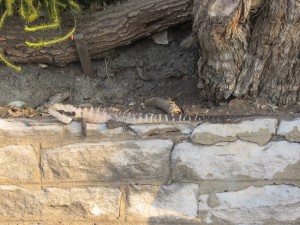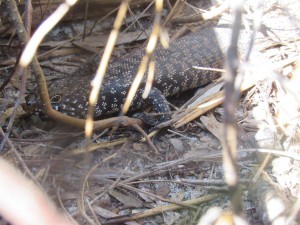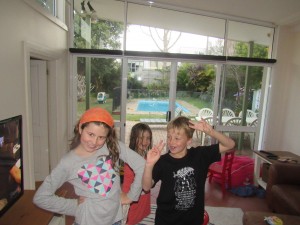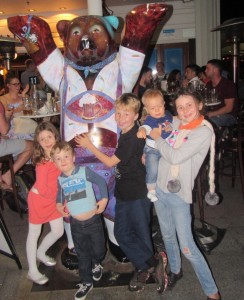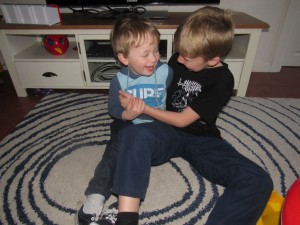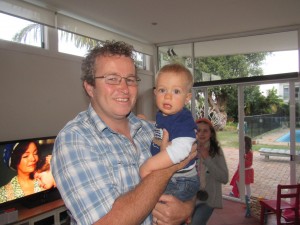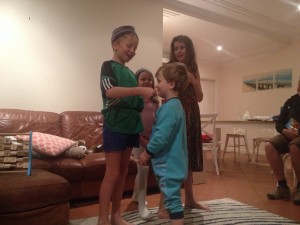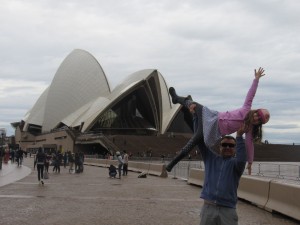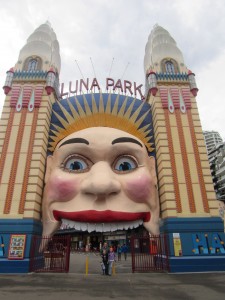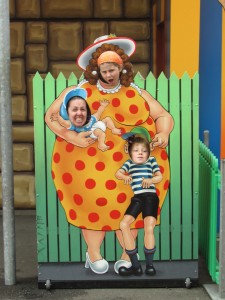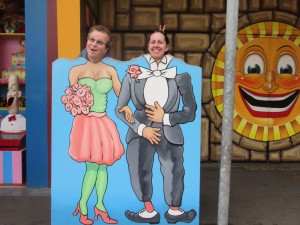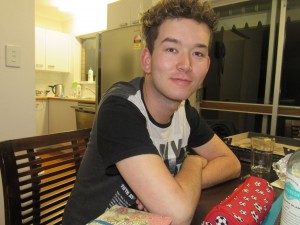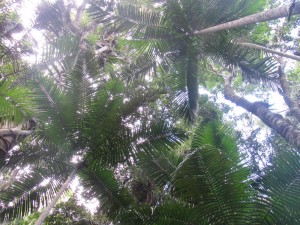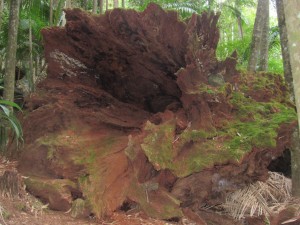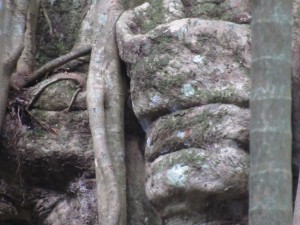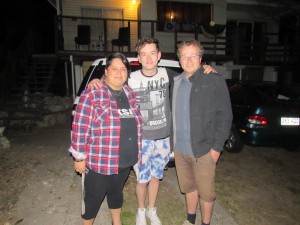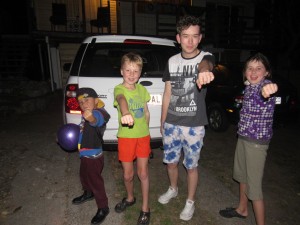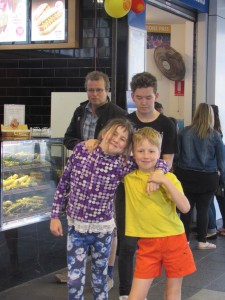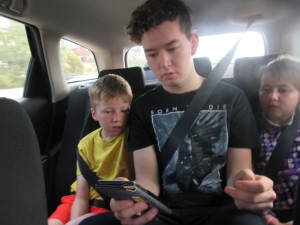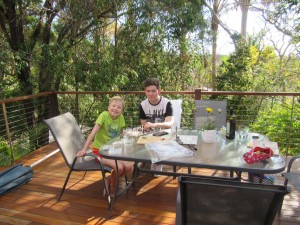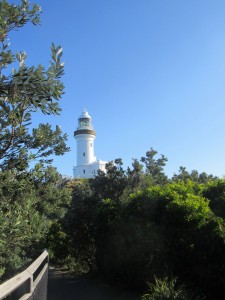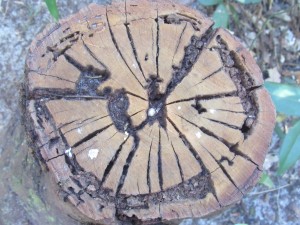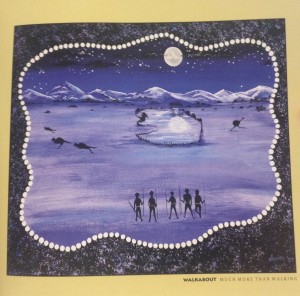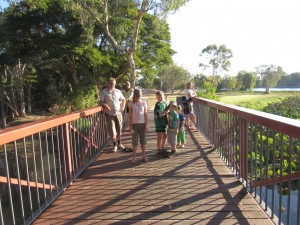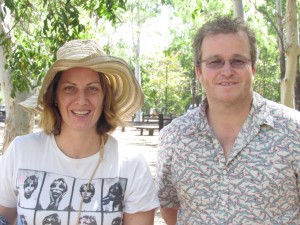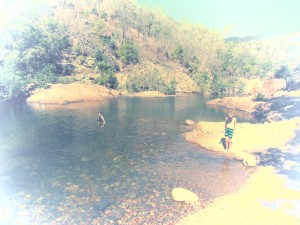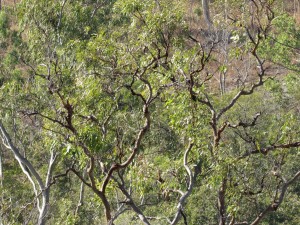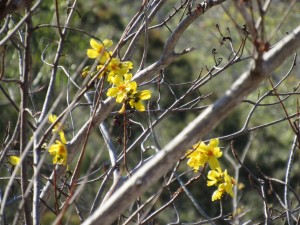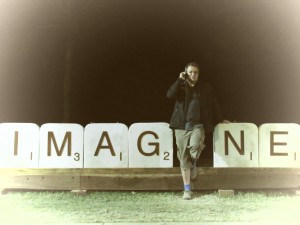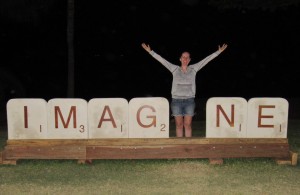We travelled vast distances throughout the 6 weeks in Australia. Although we have travelled from Cairns to Melbourne, describing the journey by placing those two places side by side in the one sentence gives no indication of the 3,000km that we have covered, the vast space separating both places, the nothing that is something and everything magical in between. Alive, dead, arid, humid, colourful, monotonous, lush, noisy, serene, regenerating, decaying, fleeting, ancient, traditional, post-technical, effervescent, silent, migratory …… the descriptions go on.
Category: Australia
-
Not the sound of silence
Not sure exactly how many hours of driving time that has been….after one intolerable 9 hour traveling day, we decided against such long stretches in the car, and managed the journey in acceptable (for all) bite sized chunks, taking in interesting stops en route.We have played I-Spy, practiced “Spelling Bee”, shared the Kindle, read books, talked, solved riddles and puzzles, sang songs, shared silences and listened to lots of music.We have reflected on our favourite songs/music from our last six weeks in Australia.Daniel’s is “Adam” by Natasha Atlas, evocative of an unknown, yet soothing in its melody. He liked to put the song on repeat, which would have lasted longer than my tolerance of listening to it repeating about 5 times! I love the song, but can’t listen ad infinitum.My choice is “Across the Universe” by the Beatles…..’images of broken light which dance before me like a million eyes, they call me on, across the Universe’……chosen because it’s a song we all sang at the top of our voices together while driving; It is also Daniel’s choice as he says it reminds him of Ilona (who can pick a Beatles song from a mile away…..despite her not being overtly exposed to their music!).Ilona’s music of choice was “Moldavian Tryptich” from Donal Lunny and Marta Sebestyēn because she likes it and she likes the rhythm! (I think it’s because it opens up a different world which she doesn’t quite understand, and its change in tempo from a slow ballad to a full blown chaotic music fusion in the end is quite reflexive of her approach to the day…..slow in the morning leading to the crescendo of her night-owlishness, wanting to have the ‘craic’ and reluctance to go to bed).Tadhg chose/chooses to listen to Lorde’s “Tennis Court”….and he is in the process of learning the words….‘Don’t you think that it’s boring how people talk, making smart with their words again well I’m bored……. We’re so happy, even when we’re smiling out of fear. Let’s go down to the tennis court and talk it up like yeah (yeah)’. He also has learnt a song recommended by one of his classmates, which is a mash up of lines from various songs/artists that tells a story of taking a test at school. -
The Great Ocean Road
We’ve had a relaxing four days on the South Victorian coast. The great Ocean Road was built post WW1, by returned servicemen, and as a monument to those who never returned from war.
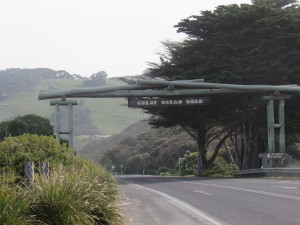
Our good neighbours (from Remuera 2014) kindly let us stay in their bach in Lorne, which was fantastic, steeped in family history and gave us a sense of change to the area over the last 100 years; while also giving us a slice of the beauty of this part of the world.
Sea views were breathtaking, and changeable by the minute.
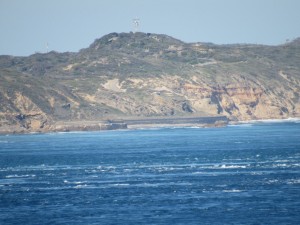
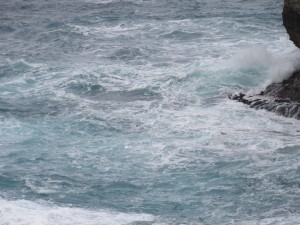
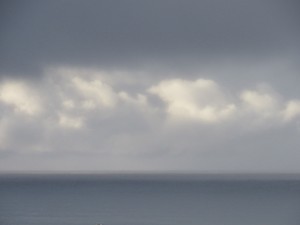
A bird bath on the deck prompted daily visits, seemingly on a strict schedule, of a variety of birds – rosettas, cockatiel, kookaburra, the grey and pink ones….and many others that I shamefully don’t know the names of!
Daniel came down with a terrible fever, but it was the best place ever to have to take it lemon-squeezey and recouperate. The kids loved having two whole days holed up, in front of a log fire, playing board games and doing very little (they reluctantly went for a drive in day 3!).
I went for a gorgeous long walk on the seashore and was amazed with the micro details (remnants of volcanic activity – the formation of canon-balls in the sandstone; remnants of petrified wood; lattice hewn sea rocks, with pretty patterns; impressive seaweed and enticingly sandy beaches, with fabulous surf…..alongside the absolute beauty of the coastal area, with a diversity of grand beech forests, pretty estuaries, majestic sea stacks, arches and blow holes all along the stretch of the Great Ocean Road.A place Of great tranquility.
We went further round the coast to the Twelve Apostles, which has amazing geological formations. Text book geography field trip location!
-
Canberra
We didn’t think we would have so much fun in Canberra but we did. Australians seem to view their capital as somewhat dull, artificial and not a desirable place to spend any time due to inclement weather and it’s somewhat inorganic development. Canberra is the capital of Australia, where the government sits, but it should be called the museum capital as there are SO many museums here.
Canberra was perfect, enjoyed by the four of us – and there was still more that we all wanted to see by the time we left. We extended our 3 day stay to 5.
The kid’s favourite place was a science learning centre, called Questacon. From Tadhg’s blog: “Questacon is a science place that you can play, watch and do on the first floor, and explore. There was a robot that you could direct to do exercises, make him speak lines from films, do sound affects and also answer questions. I had a go and thought he was awesome. In a room called EXCITE there was fun stuff like playing against a robot in air hockey (the robot nearly always won), you could play another table hockey with 4 people (shaped like a cross) with a spinning wheel thing in the middle which made the puck go randomly. I loved the room with all the logic and maths puzzles. We stayed there a long time, and I also loved the connect sand in that room. “Perception Deception” was the first room. One was four wires with spaces I between the wires, that if you close your hands around them and make circles with your joined hands over the wires, it felt like you were touching glass, although there was nothing I between your hands. That room showed me that my mind can do tricks, as sometimes your brain thinks it sees or feels something.”
We also went to:
1. Australian War memorial, which was the first museum Ilona, Tadhg and Daniel visited on the first day. The first part is about ANZAC and there was WWII.
2. Australian Parliament (not a museum but where the politicians sit).
3. Royal Australian Mint which is a factory where they make Australian coins/money. There was a computer game where you had to put the old money over to pretend to buy things in the 1960s, which kept Ilona and Tadhg busy (their maths lesson for the day!). They had pounds, shillings and pence then, not the Australian Dollar and Cents. The Australian two dollar coin is smaller than the one dollar coin, and nobody could tell us why. Even though the mint is a factory, there was no free sample of what they produce on the way out!
4. National Museum of Australia which was great to look at all the aboriginal stuff and all the inventions. Tadhg’s take on the museum : “They gave me a booklet to find things in each room. The aboriginals do a dance to welcome visitors. The white people were allowed to just shoot the aboriginals, just go over and go bang. I don’t think that was fair. They had a Wiggles exhibition as they came from Australia. They showed how the opera house was built in Sydney. There was a cool room called “K Space” where we made a robot on screen then my sister and I had to work together to try to move it. I was controlling the feet and right hand, Ilona was controlling the head and left arm. We had to work together.
There was a pig with one head and two bodies which had been born but they kept in a jar. They also had snakes preserved”.
5. National Capital Exhibition, which is a museum showing how and why Canberra City was planned and built to be the capital. American husband and wife architect team who had never visited the location won the competition. The kids spent their time playing with the great supply of Lego they had there. For my contribution, I made an aboriginal flag from Lego (red black and gold), alongside a brown and white chessboard…….well we were in the political capital.
6. Contemporary art gallery (rather small – just two rooms, but still interesting: they had copies of Beckett’s Endgame, Waiting for Goddot and Krapp’s last tape as an installation, all of which had shapes perfectly cut out of them, like someone used a large paper puncher).
7. National Art Gallery, which I had the luxury of exploring on my own, while the others were viewing one of the four copies of the Magna Carter in the Parliament.
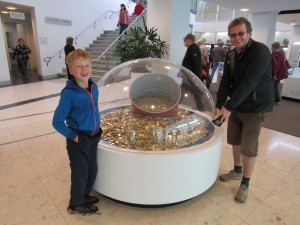
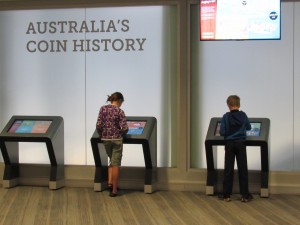
-
My Fellow AUS-TRA-ALIENS
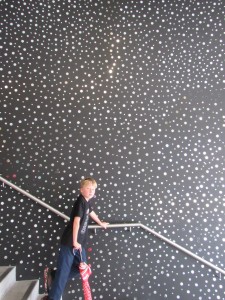
We spent an inspiring afternoon in the Museum of Contemporary Art, at The Rocks, in Sydney.
Pictures speak a thousand words, so here are my favourite pictures: I was particularly interested in aboriginal narratives, but also loved Aleks Danko’s drawing upon his own history in his art, installations and strong political messages. Very dark humour.Aleks Danko’s work is below. I loved how he played with words, and whoever curated his exhibition cleverly used reflections and mirrors so whimsically.
There was a strong ‘house’ theme in his work, which also resonated with something of the inner traveller in me.
-
SYDNEY
Sydney is a fantastic city. We spent a few days in Manly, by the north head of the harbour. We spent one day walking around North Head, which is part of the national park that flanks the harbour.
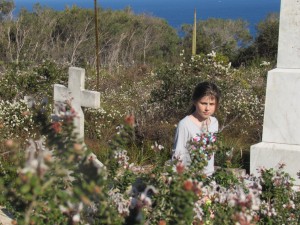
North Head has an interesting military history, abundant fauna (I spied a gowana and another dragon like reptile out sunning themselves), poignant remnants of the hardships faced by new migrants (quarantine station, and accompanying graveyard – a beautiful place to be buried, but far from home for many).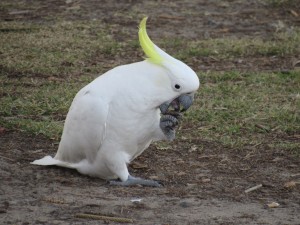
We also saw whales skirting the mouth of the harbour.We caught up with Sean O’Connell and Azri, and got a great insight into Australian politics. Intense discussions over dinner.
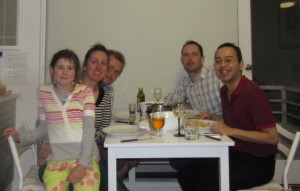
The next few days we visited our old neighbours from Auckland – the Rouvrays, who also live in the North Shore of Sydney. Our stay in their house ranged from swimming in their pool on a warm Winter sunny afternoon, to the most amazing continuous blanket lightening on the evening before we left…..with generous hospitality, great conversation and delight with the kids meeting each other again, in between!
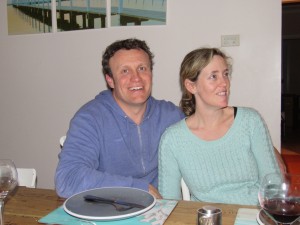
We took a ferry into the city, gliding past the Sydney Opera house on the water, under the watch of the Sydney Harbour Bridge, and spent the day enjoying exploring the Rocks, walking the Bridge, visiting the Contemporary Art Gallery.
Daniel and I even had a date night (thanks to the Rouvrays kindly minding Ilona and Tadhg!) – we went to an Art House cinema in the eaves of the Opera House, where we saw “Last taxi to Darwin”. At least I saw the Australian desert on screen!
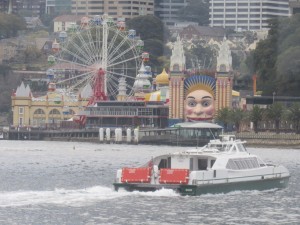
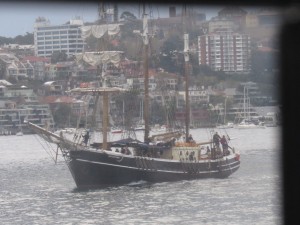
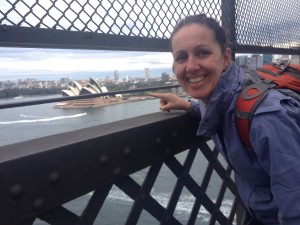
Ilona randomly bumped into an old classmate from her 2nd year at school, in Luna Park. Bizarre! Lots of colour and fluster!
We got a most unique perspective of Bondi Beach – I guess very few visitors get to see the iconic beach so empty and with torrential rain! It didn’t deter the surfers. For what it’s worth, I preferred Manly beach to Bondi!
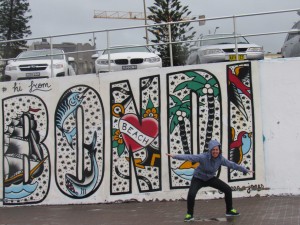
-
Brisbane – Rileyroo!
Brisbane to Byron Bay to Coffs Harbour before reaching Sydney. The most important purpose of our Australian trip was to catch up with Riley, and spend some time with him in Brisbane.
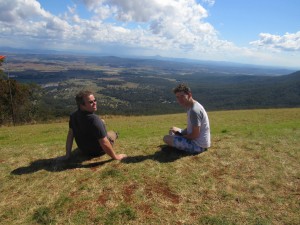
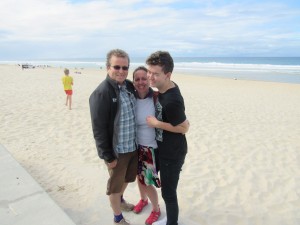
We spent a lot of fantastic time with Riley in Brisbane. All grown up, independent and a great tour guide, with a maturity recently matured! Picnic lunches enabled by public access bbqs mostly everywhere (a tip: we found Teflon sheets to use on public bbqs, which means you don’t have to clean them before use, and leave them clean after use).
Tambourine National Park was truly spectacular – tree formations and foliage were grand with amazing natural intricacies.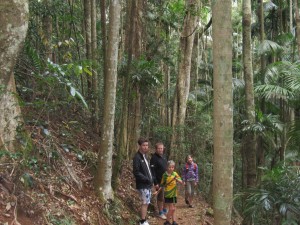
We also spent time with Riley’s mum, who has an amazing generous capacity. She helps the homeless, invariably (but not exclusively) New Zealanders, who have no access to the Australian welfare system when living here (Australians have access to the NZ welfare system, automatically).
She had taken in a family of 9, just a few days before we arrived, as they were destined for the street. Although there were people everywhere when we arrived at her three bedroomed house, it was clearly a ‘giving’ house, a refuge for many and filled with aroha. We also were privileged to help out at a weekly street feed beside Woodridge train station, and had a first hand experience of poverty in Australia.
Humbling
It’s very easy to be homeless while traveling, given that we can cross people’s palms with plastic and have resources to feed ourselves and give ourselves shelter.
Byron Bay was beautiful. We spotted whales migrating when we arrived up to the lighthouse. Perfectly peaceful and picturesque.
-
Passed to the Present
My cousin John Power introduced me to (seemingly!) intractable questions about time.
Does the past, present and future exist outside our minds and filing/classification processes? Some cultures/languages do not have a future tense. In Irish, we overuse the special verb “bí”, to be, when translating into English. “I do be” can be (!) heard, or “he is dead”, relegating events into the present tense, rather than the past (“he died”). If different time periods do exist, how do we define or measure them? In the nano seconds that it takes to process the stimuli around us through our senses, the moment has passed and we are not in the present anymore.
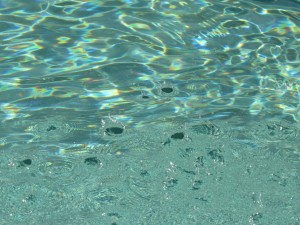
In the past two years in Auckland, I was introduced to the concept of “infinite games” by a cool psychology lecturer (Niki Harre of Auckland Uni) I worked with, based on James Carse’s work from the 1980s. Infinite games are those we play for the sake of continuity alone – such as love/meaningful relationships; but also of interest to my work for preserving/caring for our environment for future generations, and how we can govern to ensure such infinite games can take place.
With these ideas as a backdrop, I have just read Milan Kundera’s “Ignorance” and am in the process of reading Witi Ihimaera’s “Maori Boy”…..and some of these concepts are re-emerging and grabbing my attention!
Witi Ihimaera (in Maori Boy), describes Maori as walking backwards into the future.
Maori have a time called ‘i ngā wā o mua’ – the days that have gone before us. It alludes to a way of looking at the past as something that doesn’t lie behind us but is in front of us. People and events are not to be consigned to the past tense but are watching over us and still waiting to be accounted to. Maori see time as a spiral, turning in on itself, crossing over itself (and they travel through life with their whakapapa ever with them).Kundera talks about the creative revival that occurred in Prague prior to the Russian/Communist overtaking in the 1960s. He describes all predictions of the future being wrong. The Czechs (post war to late 1960s) believed that they had an infinity ahead. They had it wrong, but they lived in a state of joy that led to their creativity to flourish. After the Russian invasion, with no inkling of oppression and Communism’s end, the infinity they inhabited was very different. It was not the pain of their current life but the vacuity of the future that sucked their energies dry.
Kundera also argues that memory cannot be understood without a mathematical approach. However no one has calculated the ratio between the amount of time in the lived life and the amount of time from that life that is stored in memory. Does memory retain one millionth, a hundred millionth, an infinitesimal bit of the lived life?
If someone could retain their memory of everything they had experienced, they would not be human!So what fragments of the past do we remember? Things with words attached to them? Pictures that we recall on viewing over and over again?
Will this blog come to determine what I remember of my travels, despite it representing only a fraction of what I am experiencing, and despite it not being able to articulate let alone represent the smells, noises and tastes that I encounter.Back to Kundera again, who observes
“we will never cease our critique of those persons who distort the past, rewrite it, falsify it, who exaggerate the importance of one event and fail to mention some other. But such a critique should be preceded by a critique of memory, which is capable of retaining a paltry little scrap of the past, and no one knows why just this scrap and not some other one, since in each of us the choice occurs mysteriously, outside our will and our interests”.An old archival document, a diary, a blog, preserves notes by an authentic witness to a certain past. It speaks of events that the writer has no reason to repudiate, but which memory may not be able to confirm, other than that it is transferred through words and language.
Bono sang “every poet is a thief”, which, out of the context of creative originality, conveys a deeper idea of our memory of words and how our personal association with words creates distorted(?!) understanding, nuanced meanings and subtleties.“We won’t understand a thing about human life if we persist in avoiding the most obvious fact: that a reality no longer is what it was when it was; it cannot be reconstructed” – Kundera
Which brings my thoughts to Aboriginals and their song lines. From Dreamtime (their past boundless infinity) landscapes are sung. Through walkabout, memories and realities are encapsulated through music, a time capsule transmitting information. Imagine singing your landscape only to find a big city plonked where it shouldn’t be (from your song).
Can reality be constructed?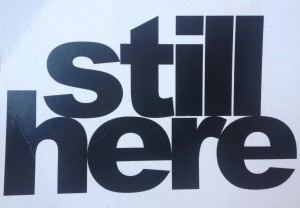
(I love this highly political aboriginal postcard that was given to me in Cairns).The spiral of time is always turning.
Do we go to the future looking backwards?P.S. Is it being presumptuous to write a blog, overestimating my own self importance? Who will look at it? Or overestimating the interest of either myself or others in the future? Just as we relegate the past, do we over-inflate the future? How do we live in the present?
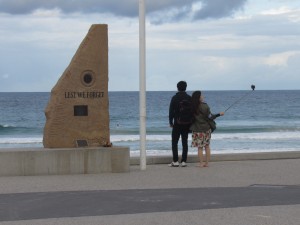
I quickly spotted and snapped this scene in Surfer’s Paradise yesterday. Oh! The sweet irony makes me giggle! -
Ectoderm Testudines – Yertle!
 This is the Ross River that slices through Townsville. Pretty, picturesque….probably because it’s profoundly populated by (p)salties.
This is the Ross River that slices through Townsville. Pretty, picturesque….probably because it’s profoundly populated by (p)salties.Under this particular bridge, people go to feed, not the trolls or ducks but, the turtles (Krefft’s river turtles).
Queensland, and the Townsland area has 6 of the 7 species of sea turtles worldwide (I think that’s what the lady at the turtle hospital told us). These Krefft’s are freshwater ones, and are described as “super abundant” in this location.
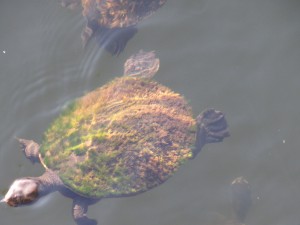
The spot was teeming with them! They were clambering over each other.
 Other fish could be seen amongst and under them. Some were covered in what looked like moss (possibly algae?!)
Other fish could be seen amongst and under them. Some were covered in what looked like moss (possibly algae?!)

-
Townsville Tourists
We stayed in Townsville with the Hampton’s. Katrina – a kiwi – and Pete from Cairns, along with their three gorgeous kids.
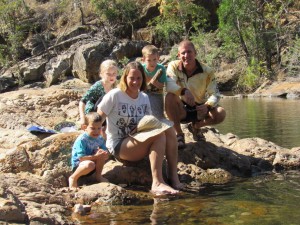
Katrina and Daniel have been friends since his Putaruru farming days.
Daniel spies a kookaburra. In fact two perched above our picnic table, one of which one swiped Tadhg’s sausage and made off with it!
They are amazingly mad looking birds, with a Spike like headdress. we went for a 5km tramp to Kookaburra creek, so we heard lots of their trademark screeching.
Idyllic days for our kids! Even though locals think it too cold to swim, Ilona and Tadhg are in water every day. Saturday, it was in Alligator Creek (yes, I know, name raises numerous questions, rather than being part of a specific and apt naming regime – pity I don’t know the aboriginal name, as no doubt that would be more telling).
The country seems to be teeming with life! Flora and fauna is so different to me. I have the same appreciation as I had when first arriving in New Zealand. A jaw-opening awe. (I’ve kept my jaw closed here in Australia, as I’d be sure to catch flies). In this creek, there were thousands of tadpoles at the edge of the water.
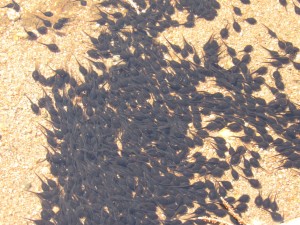
Pete, being a Queensland Boy assured us there were no “salties” (fresh water crocs) in this creek, that there may be a few “freshies” (endemic Johnston crocs – which may nip you, but harmless). Despite his assurances, Dan and I remained on high croc alert when the kids were in the water. Not sure what we could have done, if a croc were was there (Daniel said he had rocks to hand!).
As crocs are now a protected species, there are more of them, and numbers are increasing as their species regenerates…….so my thinking is that where there were none 20 years ago, they may have recolonised, as they are great explorers and travellers.
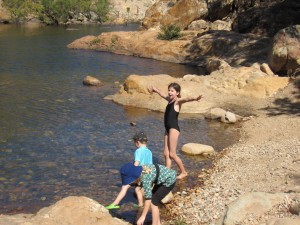
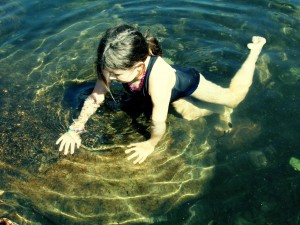 Ilona thought my croc angst particularly funny, and said she went out further in the creek to taunt me….hmmmm
Ilona thought my croc angst particularly funny, and said she went out further in the creek to taunt me….hmmmmI was feeling like the overprotective parent (not trusting local knowledge), but also the foolish one who exposed their kid to undue extreme risk of croc attack!
-
Cogito Ergo Sum
Managing to strike cities and towns at the right time, or else there is a vibrant scene all over Australia all the time! Townsville has a sculpture festival this week, along the Strand. This of course has to be my favourite (hat tip to Dad, Tony Murray!)
Other really impressive sand art:
P.S. The fish is for Tim, and my fellow yellow-bellied siblings…..you know who you are! Impressive Wexfish. And FYI Wexfish don’t think at all.
